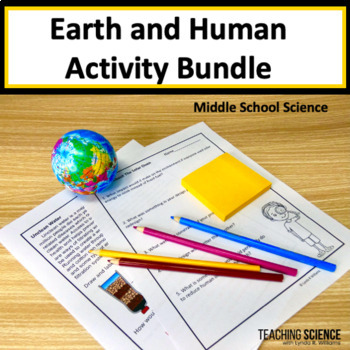Natural Hazards & Human Impact on the Environment Science & Renewable Energy
- Zip

Products in this Bundle (7)
showing 1-5 of 7 products
Also included in
- This is a full-year earth and space science curriculum bundle. If you teach middle school earth science, you need this bundle! It is perfect for schools where 6th-grade science addresses all the Earth and Space Science standards. This bundle will save you 20% and cover all the Earth Science StandardPrice $132.04Original Price $165.05Save $33.01
- This NGSS Middle School Science Bundle is my biggest bundle! It includes all my middle school science units, Bell Ringers, Jeopardy-style games, Assessments, and Informational Text Science Units for Middle School. It addresses all the NGSS standards for 6th, 7th, and 8th Grade NGSS science. Save whePrice $489.55Original Price $699.35Save $209.80
Description
This bundle is for the Earth and Human Activity Strand for Middle School Science. Students should understand the impacts of humans on natural resources, the impacts of natural hazards on humans, and the impacts of human activity on Earth processes. ✅ Save 20% by purchasing as a bundle! This bundle covers the standards in the Earth and Human Activity Strand as part of the Earth Science Middle School standards.☀️
This Human Impact Bundle Includes:
- Distribution of Resources NGSS MS-ESS3-1.
- Natural Hazards: Analyzing and Interpreting Data NGSS MS-ESS3-2.
- Human Impact on the Environment MS ESS3-3
- Human Population and Impact on Natural Resources NGSS MS ESS3-4
- Climate Change
- Renewable and Nonrenewable Energy
- Environmental Research Project
Teachers Love This Bundle on Human Impact!
Anne ⭐️ ⭐️ ⭐️ ⭐️ ⭐️ Extremely Satisfied
This is an amazing bundle that covers all the standards in this strand! Each unit had interesting activities, slide shows, worksheets, assessments, and reading passages. Students had to think critically, and It is all organized really well! I would give it six stars if I could!
Lance ⭐️ ⭐️ ⭐️ ⭐️ ⭐️ Extremely Satisfied
Wonderful bundle that really saved me both money and time. Each unit is well-planned and organized with great activities. Make more like this!
There are five units in this bundle. If you did every single piece in each unit it would take you about a month to complete. Each unit has a suggested schedule at the start of it.
♺♺♺♺♺♺♺♺♺♺♺♺♺♺♺♺♺♺♺♺♺♺♺♺♺♺♺♺♺♺♺♺♺♺♺♺♺♺♺♺♺♺♺♺
This bundle covers these standards:
- NGSS MS-ESS3-1. Construct a scientific explanation based on evidence for how the uneven distributions of Earth's mineral, energy, and groundwater resources are the result of past and current geoscience processes.
- NGSS MS-ESS3-2.Analyze and interpret data on natural hazards to forecast future catastrophic events and inform the development of technologies to mitigate their effects.
- NGSS MS ESS3-3 Apply scientific principles to design a method for monitoring and minimizing a human impact on the environment.*
- NGSS MS ESS3-4 Construct an argument supported by evidence for how increases in human population and per-capita consumption of natural resources impact Earth’s systems.
- NGSS MS ESS3-5 Ask questions to clarify evidence of the factors that have caused the rise in global temperatures over the past century.
- NGSS MS-LS2-5. Evaluate competing design solutions for maintaining biodiversity and ecosystem services.* [Clarification Statement: Examples of ecosystem services could include water purification, nutrient recycling, and prevention of soil erosion. Examples of design solution constraints could include scientific, economic, and social considerations.]
This bundle also addresses several Utah SEEd standards:
- Utah SEEd Standard 8.4.1
Construct a scientific explanation based on evidence that shows that the uneven distribution of Earth's mineral, energy, and groundwater resources is caused by geological processes. Examples of uneven distribution of resources could include Utah's unique geologic history that led to the formation and irregular distribution of natural resources like copper, gold, natural gas, oil shale, silver, and uranium. (ESS3.A)
- Utah SEEd Standard 8.4.2
Engage in an argument supported by evidence about the effect of per-capita consumption of natural resources on Earth's systems. Emphasize that these resources are limited and may be non-renewable. Examples of evidence include rates of consumption of food and natural resources such as freshwater, minerals, and energy sources. (ESS3.A, ESS3.C)
- Utah SEEd Standard 8.4.3
Design a solution to monitor or mitigate the potential effects of the use of natural resources. Evaluate competing design solutions using a systematic process to determine how well each solution meets the criteria and constraints of the problem. Examples of uses of the natural environment could include agriculture, conservation efforts, recreation, solar energy, and water management. (ESS3.A, ESS3.C, ETS1.A, ETS1.B, ETS1.C)
- Utah SEEd Standard 8.4.4
Analyze and interpret data on the factors that change global temperatures and their effects on regional climates. Examples of factors could include agricultural activity, changes in solar radiation, fossil fuel use, and volcanic activity. Examples of data could include graphs of the atmospheric levels of gases, seawater levels, ice cap coverage, human activities, and maps of global and regional temperatures. (ESS3.D)
- Utah SEEd Standard 8.4.5 Analyze and interpret patterns of the occurrence of natural hazards to forecast future catastrophic events, and investigate how data is used to develop technologies to mitigate their effects. Emphasize how some natural hazards, such as volcanic eruptions and severe weather, are preceded by phenomena that allow prediction, but others, such as earthquakes, may occur without warning. (ESS3.B)
See the preview for more details!
My units include slide shows, labs, reading passages, lesson plans, follow-up pages, and more!
These resources are created by Lynda R. Williams at Teaching Science
Follow me and get news of my new resources. Each new resource is discounted by 50% for the first 24 hours!
You will love my other resources for middle school science!
Exothermic and Endothermic Reactions
Thermal Energy and Particle Motion
Waves: Transmission, Absorption, and Reflection
* My resources are secure and not editable for copyright reasons.
Resources are in ppt and pdf format.







